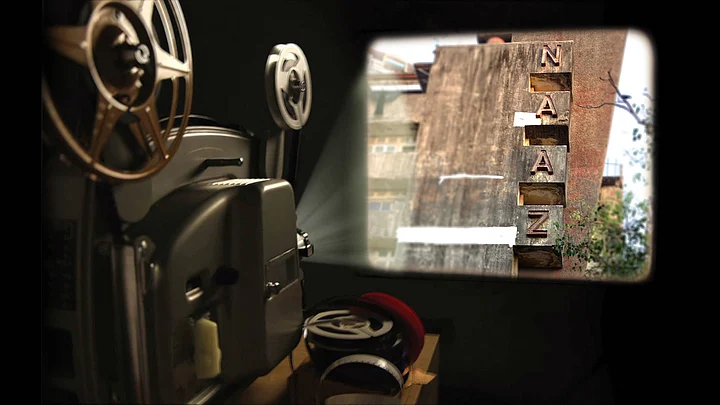Even as the new year sets in, Bollywood’s former business hub – the Naaz cinema compound in south Mumbai– resembles a ghost land.
The Naaz cinema, situated in the heart of Lamington Road, has downed its shutters for an undeterminable number of years now, after a spell of showing re-runs of action flicks starring Mithun Chakraborty, Dharmendra and Govinda primarily. Talk is that it was sold off by its proprietors, some three to four years ago, but its future is foggy.
Naaz screened some of the biggest hits of Indian cinema in its prime. Its interiors were bedecked with art-deco. Statues of cherubs and a woman with a bugle, a mirrored staircase, box seats which were used for covert canoodling and frescoes (including a woman in a lotus used for the films of V Shantaram and the emblem of Mehboob Khan Productions) were priceless in the over half-a-century-old cinema, but have gone with the wind. Or have been junked.
Incredibly enough, back in the 1960s Naaz considerately housed a creche for infants. Nannies looked after the kids in a well-appointed room, while the parents watched a movie, at no extra cost.
Vajir Singh, editor of Box-Office magazine points out that the Naaz compound was where the Bollywood trade action was. Over time, distributors and financiers who retained offices in the flanking four-storey building, moved towards the suburbs. “A film’s first hoarding would be displayed in the compound. If it was attractive and promised a hit, the product would be snapped up instantly,” Singh narrates. “Of course today, it’s promos, trailers on the internet and publicity events which do the talking.”
Also a now-defunct coffee shop, at a furlong’s distance away, was the epicentre of B-town gossip.Trade magazines also had their offices in the compound, besides a photo studio displaying posters of the vintage heroes and heroines of yore.
A rare photo of Raj Kapoor and Vyjayanthimala at the premiere of Sangam hung on the wall of a fruit juice centre for decades. “Those photos would fetch a fortune at Bollywood-related auctions today,” according to memorabilia collector Nilesh Shah, who has a vast storehouse of vintage movie posters, ticket stubs, lyric booklets and autographed photographs.
The few surviving offices in the Naaz building are in a run-down condition today, with the exception of the compact space of Sringar Films distributors run by cousins Balkrishna and Shyam Shroff. Although they reside in the suburbs, they drive down to the Naaz regularly, which is at an hour’s distance away.
The influx of film corporates which bankroll and distribute films as well the mushrooming of multiplexes, have been part of the reason for the spooky atmosphere in the once-crowded Naaz compound. Also, inquiries indicate that the next generation of the owners of the cinema wasn’t interested in keeping the auditorium going. Selling the space to developers meant sense economically. The snag is that Naaz has been in a shambles, suggesting that there has been some serious glitch in its makeover.
According to municipal corporation rules, when a cinema hall is pulled down, the developed area has to include a mini-cinema at least. In the cases of Majestic, Novelty and Swastik cinemas – all in the vicinity of the Naaz – it’s been all quiet on that must-do front.
The Imperial cinema, cheek by jowl to Naaz, continues to survive, but mainly screens sleaze flicks. As for the commodious Minerva cinema, which once premiered such memorable films as Guru Dutt’s Pyaasa and Ramesh Sippy’s Sholay, it was sought to be developed by Neville Tuli of Osians into a culure hub. Legal complications, however, has brought the reconstruction work there to a standstill for years now.
It’s the Naaz, though which was a one-of-its-kind: a cinema hall as well as a trade centre where Bollywood fortunes were made and unmade. The Chhabra Brothers, who once distributed a vast number of films ranging from the Dilip Kumar classic Ram aur Shyam to Gehri Chaal, one of Amitabh Bachchan’s lesser-known films, are no more.
A visit around the compound, clearly proves that Mumbai has acres of space which could be redeemed. Right now, the Naaz plays home to derelicts who have nowhere else to go, and on Sundays its back alley is packed with school kids playing gully cricket.
A car repair workshop and non-descript offices with leaking aiconditioners are the only stray signs of life. One of the entrances to the neighbouring Imperial cinema was adorned by a sculpture of an elephant, which is why it was often called the “Haathi Daantwaala” cinema, colloquially.
The elephant still stands, but otherwise it’s strictly a No-Entry zone.
In fact, the story of the slow fade-out of Naaz is the stuff hard-luck stories are made of. Once crowds jostled at the box-office windows. Now, it’s Ghostland.
Here’s hoping that cinema lovers don’t have to wait for an eternity to see the space put to proper use.
Or else the Naaz plot could just become a mystery like Bees Saal Baad.
(At The Quint, we question everything. Play an active role in shaping our journalism by becoming a member today.)
